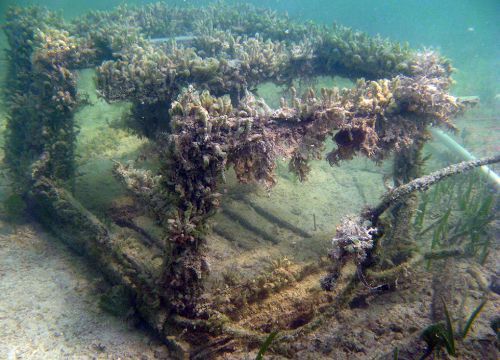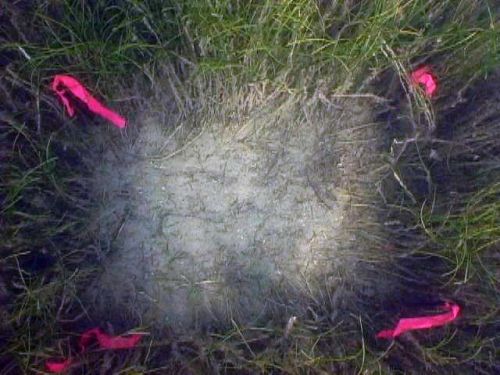Spiny Lobsters, Tropical Cyclones, and Derelict Traps
APRIL 27, 2016 -- Derelict traps generated by the Florida Keys commercial spiny lobster fishery can result in damage to the benthic habitat (meaning located on the ocean floor) such as seagrass beds and corals.
During the passage of a tropical cyclone, strong currents and turbulence are generated underwater which can move spiny lobster traps, creating the potential for lost traps and habitat damage.
An earlier study addressed the prevalence of non-retrieved traps, estimating that over 85,000 "ghost traps" reside on the seafloor in the Florida Keys. It has been estimated that ghost traps in the region kill approximately 637,622 lobsters annually.
A new study focused on the Florida Keys commercial spiny lobster (Panulirus argus) fishery shows how climate change could compound the negative effect marine debris has on the environment.
This is perhaps the first study of its kind as it shows how many spiny lobster traps might be lost given different scenarios of future fishing activity and tropical cyclone intensity.
In early April 2016, a scientific journal article on the study, titled "Tropical cyclones, derelict traps, and the future of the Florida Keys commercial spiny lobster fishery" was published in Marine Policy (69: 84-91).
The author, Amy V. Uhrin of NOAA's Marine Debris Program, looked at climate change, specifically how projected patterns of increasing hurricane intensity could make this a bigger problem as trap loss increases at higher wind speeds as does the movement of traps along the seafloor, causing more benthic habitat damage.
Damage to Habitat
The commercial spiny lobster fishery is important to the Florida Keys. According to experts at the Florida Sea Grant Program at the University of Florida, the fishery contributes over $20 million per year to the economy of south Florida and the Florida Keys. Also, 90% of Florida's spiny lobster harvest comes from the Florida Keys.
A fact sheet [PDF] the National Sea Grant program published several years ago recognized the problem of the derelict traps:
"Another significant issue in the spiny lobster fishery is the impact of ghost traps. The prevalence of trap gear that has not been retrieved is concerning as it has been noted to have impacts on benthic habitats and contribute to ghost fishing. Traps, though typically weighted with cement, are still capable of drifting large distances with currents along sand or seagrass causing habitat damage through abrasion or entanglement. Once the line and buoy are separated from the trap, lines may drift with the currents and entangle marine organisms or, more likely, entangle reef structures."
Uhrin's study evaluated three scenarios of tropical cyclone intensification across four levels of fishing effort (based on number of traps used). The study takes the position that derelict traps and marine debris generated by their degradation will increase as hurricanes intensify in the Florida Keys. In order to create the scenarios, Uhrin carefully looked at historical data of both fishery effort and patterns in the region and calculated future projections, or predictions, of monthly trap loss as related to maximum wind speed under the three levels of tropical cyclone intensification.
Outlook for the Future
The article suggests that "by maintaining existing fishing effort in the coming decades, trap loss could exceed 11 million over 60 years depending upon the rate of tropical cyclone intensification."
Even a scenario of existing fishing effort with a relatively unchanged (i.e., business-as-usual scenario) hurricane intensification would generate over 6.5 million lost traps on the seafloor over 60 years, and create the potential for more than 3 million square meters of injured habitat. This is not including the potential for additional injuries during high wind events when the debris is likely to be moving across the seafloor.
Uhrin concludes, "The legacy of trap debris in the Florida Keys combined with possible increased inputs of yet more trap debris resulting from a future rise in tropical cyclone intensity presents an immediate challenge for both fisheries management and climate adaptation planning and underscores the importance of an effective process for addressing these issues."
Amy V. Uhrin is currently Chief Scientist for the NOAA Marine Debris Program, where she oversees the research portfolio, leads internal research projects, and oversees Program-funded external research projects. Her work has addressed issues of natural and human-influenced disturbances in seagrass and other coastal ecosystems, including effects of hurricanes, wave energy, vessel groundings, and commercial fishing gear.
Related Information
Commercial Spiny Lobster Trap Fishery Florida's Spiny Lobster Fishery: A history of user conflict [PDF]
Last updated
Tuesday, April 1, 2025 8:35am PDT
 An official website of the United States government.
An official website of the United States government. 

